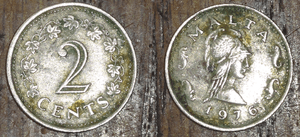Coins of the Maltese lira

Coins of the Maltese lira have been struck from when Malta adopted decimal currency in 1972, to 2007, after which Malta adopted the euro. There were 10 mils in one cent, and 100 cents in one Maltese lira.
First series (1972–1982)
The coins in this series replaced the pre-decimal Pound Sterling which had been in use in Malta since 1825. Therefore, the sizes for some coins were similar to their pre-decimal equivalents, for example the 5c was similar to the shilling and the 10c to the two shillings. These coins were designed by Christopher Ironside OBE.
In June 1975 an octagonal 25 cent coin was introduced to commemorate Malta becoming a republic within the Commonwealth of Nations on 13 December 1974. The new coat of arms appeared on the obverse side, and the 25c coin was the first coin to depict the new republic coat of arms.
| Image | Value | Diameter | Composition | Edge | Obverse | Reverse | first minting | withdrawal |
|---|---|---|---|---|---|---|---|---|
| 2 mils | 19mm | Aluminium | plain | Maltese Cross | Value | 1972 | 1986 | |
| 3 mils | 22mm | Aluminium | plain | A bee on a honeycomb | Value | 1972 | 1986 | |
| 5 mils | 26mm | Aluminium | plain | Oil lamp | Value | 1972 | 1986 | |
| 1 cent | 25mm | Bronze | plain | George Cross | Value | 1972 | 1986 | |
| 2 cent | 17mm | Cupronickel | milled | Penthesilea wearing an elm | Value | 1972 | 2008 | |
| 5 cent | 23.59 | Cupronickel | milled | Megalithic altar | Value | 1972 | 1986 | |
| 10 cents | 28.52 mm | Cupronickel | milled | Maltese galley | Value | 1972 | 1986 | |
| 25 cents | 28 mm | Brass | plain | Coat of arms of Malta | Value | 1975 | 1994 | |
| 50 cents | 32 mm | Cupronickel | plain | Great Siege Monument | Value | 1972 | 1994 |
Second series (1986–2007)
A new series was issued on 19 May 1986, which consisted of 1, 2, 5, 10, 25, 50 cents and 1 lira, all depicting local flora and fauna on the obverse and the republican coat of arms on the reverse. The 1 lira coin was introduced in this series, replacing a former banknote.[1] In 1988 a new coat of arms was adopted showing a heraldic representation of the Maltese flag, a mural crown and a wreath of olive and palm trees. The coin series of 1991 depicted the new coat of arms, but the reverse side remained the same.
-

1986
-

1991-2007
This series remained in use until 2007, being withdrawn in January 2008 upon the introduction of the Euro. They were demonetised in 2010.
| Second Series | |||||||||||
|---|---|---|---|---|---|---|---|---|---|---|---|
| Image | Value | € equiv. | Technical parameters | Description | Date of | ||||||
| Diameter | Mass | Composition | Edge | Obverse | Reverse | first minting | withdrawal | lapse | |||
| 1 cent | 0.02 cent | 18.51 mm | 2.81 g | Copper, zinc, a slight percentage of nickel | Plain | Coat of arms | Ballottra (weasel) | 1986 1991 |
31 January 2008[2] | 1 February 2010[2] | |
| 2 cents | 0.04 cent | 17.78 mm | 2.26 g | Cupronickel | Milled | Coat of arms | Zebbuga (olive tree) | 1986 1991 |
31 January 2008[2] | 1 February 2010[2] | |
| 5 cents | 0.12 cent | 19.78 mm | 3.51 g | il-Qabru (Maltese freshwater crab) | |||||||
| 10 cents | 0.23 cent | 21.78 mm | 5.01 g | Lampuki (dolphin fish) | |||||||
| 25 cents | 0.58 cent | 24.95 mm | 6.19 g | Incused beading | Ghirlanda (evergreen rose) | ||||||
| 50 cents | 1.16 | 27 mm | 8 g | Lettered | Tulliera (Maltese Fleabane), an evergreen plant that grows in the Mediterranean region | ||||||
| Lm1 | 2.33 | 29.82 mm | 13 g | Nickel | Merrill (Blue Rock Thrush), the national bird | ||||||
| For table standards, see the coin specification table. | |||||||||||
References
- ↑ The Coinage of Malta - The Central Bank of Malta
- 1 2 3 4 European Central Bank. "The euro cash changeover in Malta". Retrieved 2008-01-15.